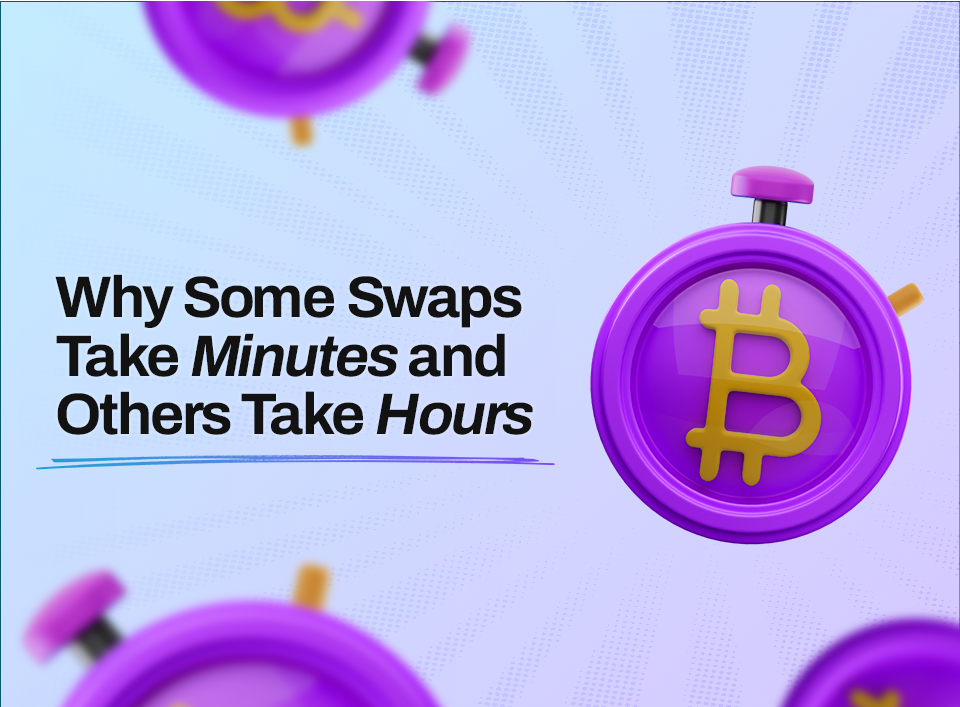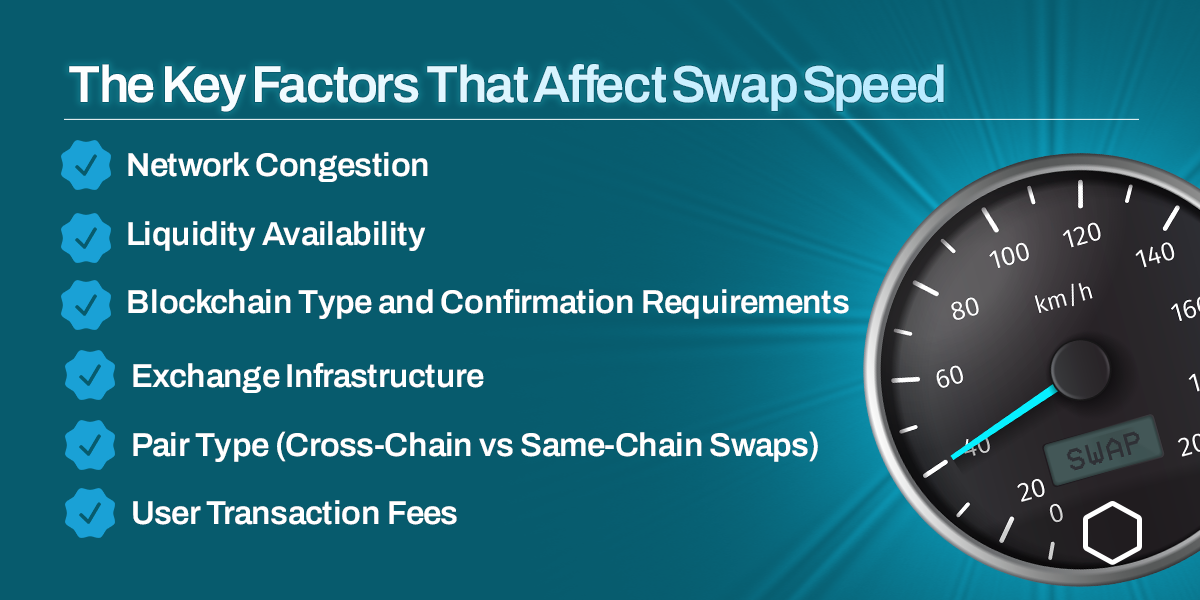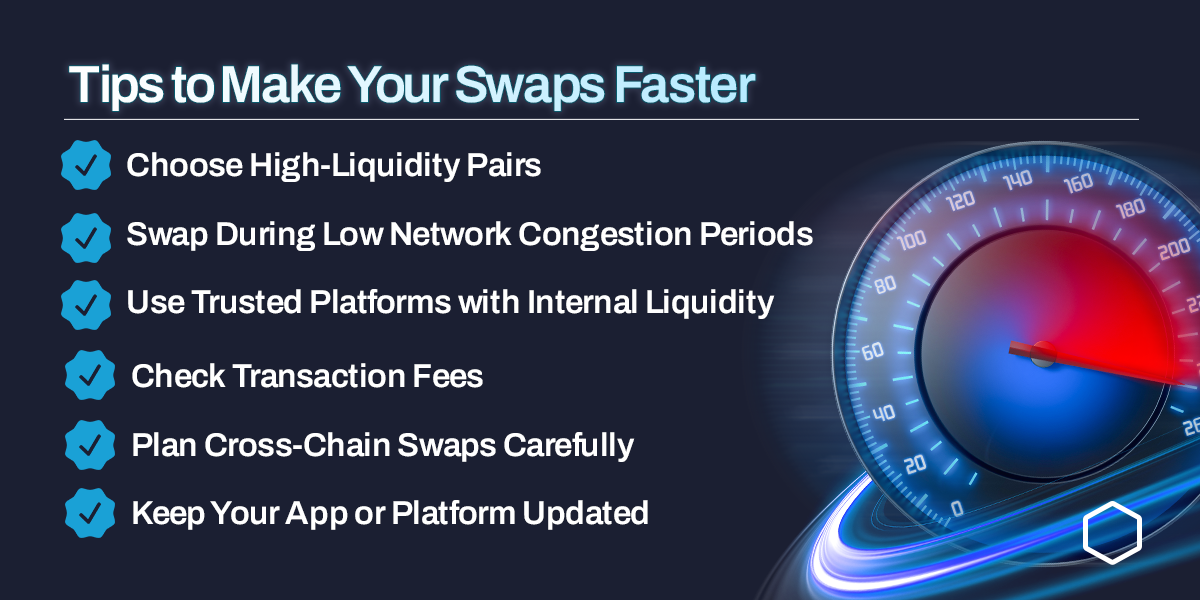Why Some Swaps Take Minutes and Others Take Hours
Learn the real reasons behind swap delays, how network congestion and liquidity affect speed, and why Obiex swaps are faster and more reliable.

Table of Contents
- What Happens Behind Every Crypto Swap?
- The Key Factors That Affect Swap Speed
- How Obiex Makes Swaps Faster and More Reliable
- Tips to Make Your Swaps Faster
- To Recap
- FAQs
What Happens Behind Every Crypto Swap
There are two main ways swaps are processed: on-chain and off-chain.
1. On-Chain Swaps:
An on-chain swap happens directly on the blockchain network. Each transaction must be verified and confirmed by the blockchain nodes before it’s considered final.
Here’s what happens step by step:
- Transaction Initiation: You request a swap (e.g., BTC → USDT).
- Broadcast to the Blockchain: Your swap request is sent to the network and added to a pool of unconfirmed transactions.
- Network Confirmation: Miners or validators pick your transaction and include it in a block. Each block has a limited number of transactions it can include.
- Multiple Confirmations: Some blockchains, like Bitcoin or Ethereum, require multiple confirmations to ensure the swap is secure. For BTC, this might be 3–6 confirmations, which can take 10–60 minutes depending on network congestion.
Why it can be slow:
- Blockchains have limited capacity, so high network activity creates a backlog.
- Lower transaction fees can delay your swap because miners prioritise higher-fee transactions.
- Cross-chain swaps require additional steps, like converting one blockchain asset to another through a bridge, which adds more waiting time.
2. Off-Chain Swaps:
An off-chain swap is handled within the exchange itself, without requiring an immediate transaction on the blockchain.
Here’s the simplified process:
- Swap Request: You request to swap BTC → USDT.
- Internal Liquidity Check: The exchange checks its liquidity pools for enough USDT to complete your swap.
- Instant Matching: Your BTC is credited internally, and the corresponding USDT is credited to your account almost instantly.
- Settlement on Blockchain: The exchange may later settle the total batch of transactions on the blockchain, reducing fees and waiting times for individual users.
Why it’s faster:
- No need to wait for multiple blockchain confirmations for every swap.
- The exchange manages liquidity internally, filling swaps instantly.
- It reduces dependency on network congestion and fluctuating fees.
3. The Role of Liquidity and Internal Routing:
Regardless of on-chain or off-chain processing, liquidity is key. Swaps only happen instantly if the exchange has enough assets on hand.
- High-liquidity pairs like BTC/USDT or ETH/USDT are easy to swap because many users hold and trade these assets.
- Low-liquidity pairs or exotic altcoins might take longer if the exchange has to source the crypto from multiple markets.
The Key Factors That Affect Swap Speed
1. Network Congestion:
Each blockchain can only process a limited number of transactions per second. When more users are sending transactions than the network can handle, swaps start queuing up, causing delays.
2. Liquidity Availability:
Without enough liquidity, swaps can’t be executed immediately.
- High-liquidity pairs like BTC/USDT or ETH/USDT are swapped almost instantly.
- Low-liquidity pairs like DOGE/SHIB or niche altcoins may take longer because the platform may need to source the required assets from multiple users or exchanges.
3. Blockchain Type and Confirmation Requirements:
Different blockchains have different confirmation rules to secure transactions:
- BTC: 3–6 confirmations (≈10–60 minutes depending on network congestion)
- ETH: ~12 confirmations (≈2–15 minutes)
- USDT (Ethereum network): ~12 confirmations
More confirmations mean slower swaps, but they also increase security and reduce the risk of double-spending.
4. Exchange Infrastructure:
How an exchange processes swaps also affects speed.
- Some platforms process swaps manually or in batches, causing delays.
- Others may experience downtime during updates or maintenance.
5. Pair Type (Cross-Chain vs Same-Chain Swaps):
The type of swap pair also matters:
- Same-Chain Swaps: e.g., USDT-ETH → ETH
- Faster because no bridging is required.
- Cross-Chain Swaps: e.g., BTC → USDT
- Slower because assets must move across blockchains via a bridge, which can introduce additional delays.
6. User Transaction Fees:
Though sometimes overlooked, transaction fees can influence swap speed for on-chain transactions.
- Higher fees usually get priority from miners and validators, meaning faster confirmation.
- Lower fees may result in your transaction being queued longer.

How Obiex Makes Swaps Faster and More Reliable
1. Instant Off-Chain Swaps for Major Pairs:
For popular pairs like BTC/USDT, ETH/USDT, and USDT/BTC, Obiex executes swaps off-chain. This means the exchange manages the liquidity internally and doesn’t wait for multiple blockchain confirmations for every individual swap.
This way, our swap can complete in under 60 seconds, compared to 10–60 minutes on other platforms during network congestion.
2. Smart Liquidity Routing:
Not all crypto pairs have the same availability. Some trades may struggle if liquidity is low. Obiex solves this with smart liquidity routing, which works like this:
- The platform checks multiple internal liquidity pools and external sources.
- It automatically finds the fastest and most efficient path to complete your swap.
- Even less popular or cross-chain swaps can be executed quickly without waiting for matching orders.
Example: Swapping ETH to a smaller altcoin on Obiex is almost as fast as swapping ETH/USDT because the system intelligently routes the trade through available liquidity.
3. Real-Time Confirmation Monitoring:
Blockchain confirmations are unavoidable for on-chain swaps, but delays can be reduced with monitoring. Obiex continuously tracks the status of transactions on the blockchain, so you always know:
- How many confirmations have been completed
- How long the remaining confirmations might take
4. 24/7 Monitoring and Support:
Even with optimised systems, delays can occasionally occur due to extreme network congestion or rare technical issues. Obiex ensures reliability with 24/7 monitoring and customer support:
- Transactions that face delays are tracked continuously.
- The support team intervenes when necessary to resolve issues.
- Users are reassured that their funds are never lost. They’re just being processed securely.
BTC → USDT Swap Delay vs. Obiex Swap
Tips to Make Your Swaps Faster
1. Choose High-Liquidity Pairs:
Pairs with high trading volume, such as BTC/USDT or ETH/USDT, are easier and faster to swap because the exchange can immediately match your order with available liquidity.
- Why it matters: Low-liquidity pairs may require sourcing crypto from multiple users, which slows down execution.
- Obiex Advantage: Even moderate-volume pairs are routed through internal liquidity pools, ensuring faster execution.
2. Swap During Low Network Congestion Periods:
Blockchain networks get busy during peak hours, slowing down transaction confirmations.
- Tip: Check network congestion dashboards (BTC or ETH) and avoid swapping during peak traffic if possible.
- Why: A BTC swap may take 10 minutes at low congestion but 45+ minutes during high traffic.
Obiex Advantage: Even during high congestion, smart batching and off-chain execution minimise delays.
3. Use Trusted Platforms with Internal Liquidity:
Exchanges that rely solely on external order books may experience delays, especially for high-volume swaps.
- Tip: Choose platforms with pre-funded liquidity pools and internal routing, which allow instant swaps.
- Obiex Advantage: Swaps for major pairs are completed in under 60 seconds, without waiting for blockchain confirmations.
4. Check Transaction Fees:
For on-chain swaps, higher transaction fees usually mean faster confirmations because miners prioritise higher-fee transactions.
- Tip: Don’t always go for the lowest fee if speed is important.
- Obiex Advantage: Internal execution reduces dependency on network fees, making swaps faster even with lower fees.
5. Plan Cross-Chain Swaps Carefully:
Swaps between different blockchains (e.g., BTC → USDT) take longer than same-chain swaps.
- Tip: If timing matters, use same-chain swaps when possible.
- Obiex Advantage: Internal routing and smart liquidity pools optimise cross-chain swaps, reducing typical waiting times.
6. Keep Your App or Platform Updated:
Older app versions may have slower processing or delayed notifications.
- Tip: Always use the latest version of your exchange platform.
- Obiex Advantage: The platform continuously updates its system for speed, reliability, and reduced downtime.

Don’t miss your next market move. Swap instantly on Obiex.
To Recap
- Swap delays are mostly caused by network congestion, liquidity, and confirmation requirements, not fraud.
- Understanding how swaps work helps you trade smarter and avoid missed opportunities.
- Obiex ensures faster, smoother swaps, so you never miss a market entry again.
👉 Trade faster, safer, and smarter.
Create your free Obiex account and swap instantly today.
FAQs
Q1. Why is my crypto swap taking so long?
Slow swaps are usually due to network congestion, low liquidity, or multiple blockchain confirmations.
Q2. What affects crypto swap speed?
Factors include network traffic, liquidity, blockchain confirmation requirements, exchange infrastructure, and pair type.
Q3. How can I make swaps faster?
Swap high-liquidity pairs, trade during low network congestion, and use platforms with internal liquidity like Obiex.
Q4. Do network fees affect swap time?
Yes. Higher fees generally speed up confirmations, especially on congested networks.
Q5. Why are swaps faster on Obiex?
Obiex uses off-chain liquidity pools, smart routing, and optimised batching to execute swaps instantly.
Q6. Are my funds safe if a swap is delayed?
Yes. Delays usually mean your transaction is waiting for blockchain confirmation.
Q7. Does cross-chain swapping take longer?
Yes. Cross-chain swaps involve bridging assets between blockchains, which is slower than same-chain swaps.
Q8. Can I monitor my swap in real-time?
Yes. Obiex provides real-time confirmation monitoring for your swaps.
Q9. Do rare crypto pairs always take longer to swap?
Often yes, due to lower liquidity, but smart routing on Obiex can reduce wait times.
Q10. Is there a way to avoid slow swaps entirely?
Using Obiex’s internal liquidity pools and swapping during low network congestion is the most reliable method.
Disclaimer: This article was written to provide guidance and understanding. It is not an exhaustive article and should not be taken as financial advice. Obiex will not be held liable for your investment decisions.
